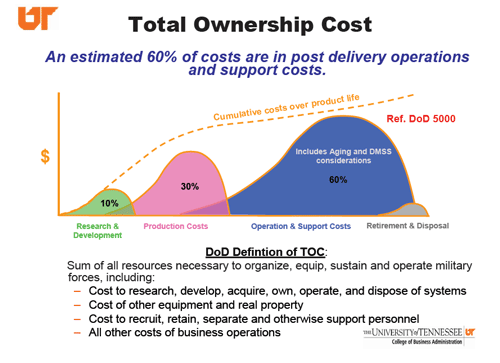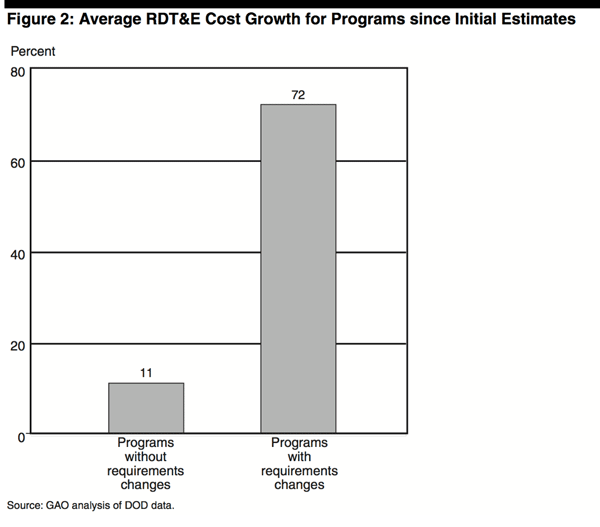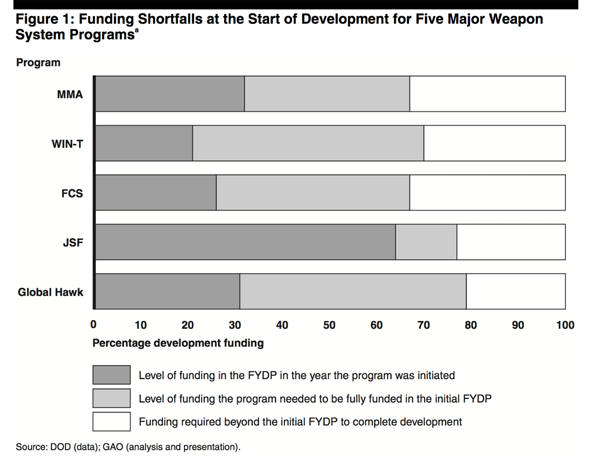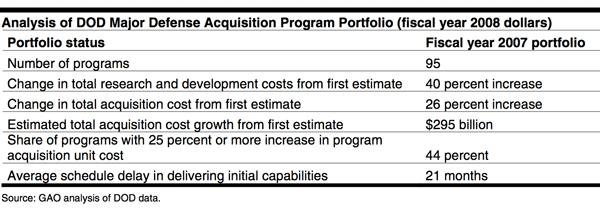
In this week’s contributions to understanding the challenge of providing capability to the warfighter, we have two assessments of the problem of cost. Cost is not an independent variable. It is contextual and depends on how you buy, what you buy, and for what purpose you buy.
– One of the issues which seems to have gotten lost in the loose Washington debate about weapons is that one buys weapons in order to prevail in war. And in wars in which there are tools available to adversaries where the good guys might not prevail. Every war will not be dominated by so-called 80% solutions; and an air and naval power like the US can provide protection for itself and its allies largely by having capabilities to project power.
– Also lost too often from the debate is the value of multi-mission weapons versus single purpose weapons. Multi-mission weapons provide capabilities in a variety of scenarios; single purpose weapons do not. Multi-mission weapons are where one wants to put ones core Research and Development as well as investments; single purpose weapons are specialized to tasks which may be necessary whether they are strategic deterrence or counter-IEDs. But without multi-mission capabilities you are reduced to a specialized power, which in Europe is often the case. The US should strategically reflect on whether the Western system as we have known it will prevail if the US goes down the 80% solution, single purpose weapon route.
***
The first contribution is by Lt. General (Retired) Michael Dunn, President of the Air Force Association and the second is by General Richard E. Hawley, (Retired), USAF. The second piece will appear next week. General Hawley served as the Commander, Air Combat Command and Commander US Air Forces in Europe. Additionally he was the Principal Deputy Assistant Secretary of the Air Force for Acquisition.
***
PART ONE
Lt. General (Retired) Michael Dunn, President of the Air Force Association
This is not an easy question to answer. There are a number of factors which go into the cost of a new system.
Number of systems purchased
Every new system has a Research and Development (R&D) component and a procurement component. The R&D costs are spread over the number of systems to be purchased. Thus if the AF only buys 20 B-2s, then the R&D costs are spread over only 20 aircraft and added to the flyaway cost of the aircraft. However, if the AF buys 1700+ F-35s, a much smaller percentage of R&D is assigned to each aircraft.
Technology/risk
Many weapon systems push the envelope of technology. When aerospace companies are challenged to build something that has never been done before, there is a chance that they cannot do it within the funds allotted. Many times companies will estimate a path to succeed, only to stumble over major, unexpected hurdles which then increase the cost. The general term that refers to this is risk. The more risk there is in a program, the more likely it is the cost will grow. And even low tech programs – with known technology – face cost growth. The example I use is the Springfield bypass in the Washington area. The project came in 10 years late and 500% over budget. Another example could be “The Big Dig” in Boston.
Use of “Off-the-Shelf Technology
This can reduce risk because usually a prime contractor knows what items with a known technology will cost. However, it is not a panacea – in that some off-the-shelf items don’t meet military requirements (e.g. can’t stand the 150 degree heat or the minus 70 degree cold or is not rugged enough to put into the dust and chaos of the field). Additionally, off-the-shelf technology today may be obsolete when the system is finally fielded. Successful systems allow for the insertion of new technologies as the system is developed.
Management Reserve
One of the ways firms help attenuate the risk – and one that is done in the commercial sector — is with a management reserve. Studies have shown that $1 spent early to solve an impending problem, reduces cost by $5 if it is spent later in the program. Unfortunately, the government process – at the Air Force, DOD, OMB, and Congressional levels wrings out “excess” funding to each program – leaving little for a program manager to address program risk.
Number of changes to the Design
Changes, like changes to a construction project cost money and cause “overruns.” This is a major driver of cost, especially if the requirements shift/change as the system goes through development. One example of this is what has happened to the Presidential helicopter – which has been hit with thousands of changes… to include a requirement to withstand Electromagnetic Pulse.
Source: http://www.gao.gov/new.items/d08674t.pdf
Unstable Funding
This is probably the largest cause of increases to weapons systems. A company is told to produce X many aircraft per year over Y many years for a total of Z many aircraft. The firm determines the most efficient way to manufacture the system, addressing literally thousands of issues (such as: how many work shifts to have, how much tooling to buy, the level of automation of the line, how many people to hire, and in what specialities, which subprimes, third tier, even fourth tier manufacturers to use, how much work to bring in-house, etc, etc). If the Congress or DOD determines there is a change in the requirement or there is insufficient funding to continue the planned buy, this has a huge impact on the cost. And built into every DOD contract are government liabilities for termination costs. Sometimes these costs are so high, there could be little savings the year a production line is terminated.
source: http://www.gao.gov/new.items/d09431t.pdf
Schedule
AF program managers are often told to buy a system at the minimum cost to the taxpayer. This may mean a production rate that is ideal for both the AF and the manufacturer … but which does not fit into the budget constraints of … say a new Administration. When a schedule is changed, costs grow.
Source: http://www.gao.gov/new.items/d09501t.pdf
Learning Curve
The first aircraft to roll off a production line is the most expensive. That’s because the workers and the line supervisors are doing this for the first time. As they become more skilled, they get more efficient. This efficiency is called a learning curve. The Air Force has seen reductions as much as 35% of the cost over time. This is important because systems are usually curtailed when the line is the most efficient.
Multi-Year Procurement.
A multi-year contract will save taxpayers money. That’s because the manufacturer can plan for longer than one year, can buy in economic quantities the items it needs for the future, can tell its sub-primes to do the same, can keep the right number of workers on the production line. Average cost savings for a multi-year procurement is about 15%. Congress rarely permits multi-year – because it removes their ability to provide oversight on a program on a yearly basis.
Weight of a System
Surprisingly, for a given level of technology, cost and cost growth closely approximates weight. Perhaps more than any other factor, this correlation predicts programs in trouble. If the weight of a system grows, so will the cost. The most famous example is the Navy A-12 – which grew so heavy that it could not take off on a land runway in less than 10,000 feet.
Type of Contract
In order to hold cost growth down, in the past, DOD has tried to use a variety of contracts (firm-fixed price, cost plus incentive fee, etc). One would naturally assume that a firm fixed price contract would be the best, because the price could not go up. However, depending on the risk, most companies will not bid on a FFP contract, especially if they are trying to develop and build a new system with lots of uncertainty.
Concurrent Test/Buy
If you think about how a manufacturer has to build a production line, he first has to build a few articles/aircraft. While he does this, he has to train the workers/engineers. After he turns over the planes to the government, the most efficient way to proceed is to continue production ,making the changes the AF needs as the line continues. Many Congressional critics maintain the AF/aerospace industry should stop the line, while the AF embarks on a 2+ year set of tests to ensure the aircraft “works.” This is both inefficient and detrimental to keeping the cost of a system low.
Proposals
One reason why systems cost so much is the government does not reimburse companies for the cost of their bids. While there are no data, indications are that the two primes who bid for the KC-X spent upwards of $50M of their own money. The effect of this is that many firms have decided it is too costly to try to sell to the government. They have focused solely on the commercial market. This hurts competition in the long term and increases cost.
Inflation
Inflation in the aerospace industry is not the same as the CPI. It hinges on numerous factors. Several of these factors are:
- The price of raw materials. When the price of titanium shot up last year, it added big dollars to many systems under procurement.
- The cost of engineers. The nation has a shortage in engineers – we are not producing enough. Many are foreign born … and either have to wait for a long time to get a security clearance … or go home after getting their degree. Over the past 3 years, wage inflation among aerospace engineers is almost 3 times the rate of inflation in the economy.
- The requirement for a “green” plant. I visited a sub-prime plant in Los Angeles where the firm (which made landing gear out of big chunks of metal) was required to make sure the air they put out of their furnace/press was cleaner than the outside air they used as input air to the press.
The rising cost of weapons systems often gets confusing, because there are many different types of costs. On balance, the aerospace industry does a great job in providing the tools, technology, and machines to keep us safe. Yes there are occasional problems, but it behooves us all to consider the industry – which accounts for a positive $40B per year to our trade balance – as our partners rather than our enemies.
***
N.B.: For an explanation of the different types of costs, see: http://www.afa.org/PresidentsCorner/Notes/Note-2-29-08.pdf.
———-
***Posted December 20th, 2009




